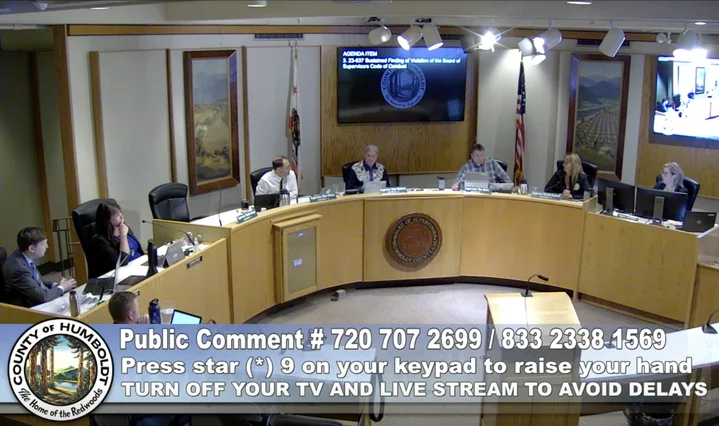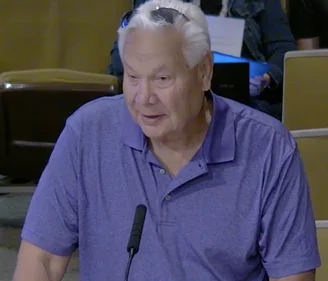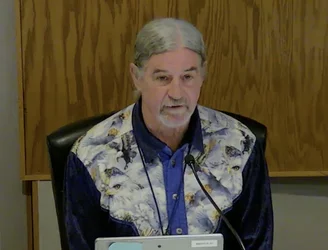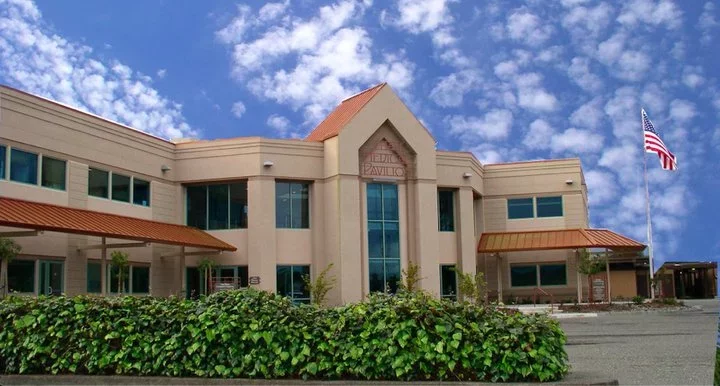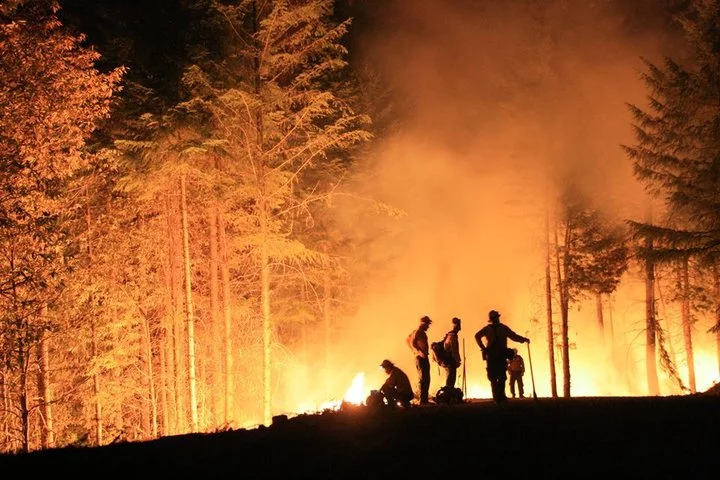New Report Says Cal State Has $1.5 Billion Funding Gap, Suggests Tuition Hikes
Mikhail Zinshteyn / Wednesday, May 24, 2023 @ 2:19 p.m. / Sacramento
Members of Teamsters, CSUEU, UAW 4123, and CFA Faculty gathered to ask for fair wages outside the CSU Chancellor’s office in Long Beach on May 23, 2023. Photo by Lauren Justice for CalMatters.
The nation’s largest public four-year university is presently incapable of affording itself.
A 70-page report nearly a year in the making by leaders of the California State University details the massive gulf between the money the system currently generates from tuition and receives in state support and the actual costs of educating its nearly 500,000 students and employing 60,000 workers.
All told, CSU’s revenues account for only 86% of the system’s overall costs — a gap of nearly $1.5 billion in 2021-22. Support for student services is the least funded relative to costs, at just 68%. The analysis is based on a highly technical set of assumptions and system data. That gap doesn’t even include Cal State’s roughly $6 billion backlog in construction maintenance projects.
A central premise of the report is that the CSU cannot afford to do the things it should be doing to help students succeed.
“The model explains why there never seems to be enough money to pay for what the universities think they need,” the report states.
As a consequence, ongoing tuition hikes are likely forthcoming. Likely more system tumult awaits, as unions are threatening to strike.
The report’s findings were presented to the Cal State Board of Trustees today.

Emma Joslyn, center, a member of UAW 4123, and Nora Cisneros, right, with CFA, during the rally. Members of Teamsters, CSUEU, UAW 4123, and CFA Faculty gathered to ask for fair wages outside the CSU Chancellorís office in Long Beach on May 23, 2023. Photo by Lauren Justice for CalMatters
“This is a lot like climate change,” said Julia Lopez, a CSU trustee and co-chairperson of the working group that wrote this report. “If we don’t heed the warning signs right now, we’re going to find ourselves in a world of hurt down the line. So that’s what we’re trying to do, to get ahead of that.”
The Cal State’s revenues from tuition and state support will be 29% to 41% less than what the system needs by 2030 unless the system finds new sources of money, warn the report’s authors, a mix of CSU trustees, provosts, campus presidents, senior system staff, a leading professor, outside consultants and the president of the student association. And that’s “even with aggressive assumptions about increases in state General Fund and tuition.”
These cost gaps don’t necessarily mean cuts to key services are imminent. “It’s not really about what cuts we’re going to make, it’s … opportunities that we do not have to invest in additional things that we should be investing in,” said Jeni Kitchell, executive budget director for the CSU.
A major cost driver for the CSU is its status as a national engine of social mobility. Its students are often low-income or the first in their families to attend college, and require more academic support to graduate, as well as added money to afford food, housing, mental health and other basic needs, Lopez said.
“If we don’t heed the warning signs right now, we’re going to find ourselves in a world of hurt down the line.”
— Julia Lopez, CSU trustee
Part of the report’s analysis included how much it would cost to improve the graduation rates of low-income students and students of color by examining the few campuses that have made the most progress in closing equity gaps. The analysis also introduced new data that’ll be closely watched, like the cost of providing each major.
This sobering analysis echoes what the state’s nonpartisan bean counters, the Legislative Analyst’s Office, said in January: Cal State’s tuition and state support will fall $100 million short of its likely costs in 2023-24.
But the solutions the report describes will be bitter pills to swallow. Annual tuition hikes are necessary to increase revenue for the CSU, the report argues, reversing course for a system that has raised tuition only once in the last 12 years.
Even steep tuition hikes, however, won’t be enough to stabilize CSU’s finances.
“From the student perspective, I don’t think we’re ever going to be fine with tuition increases.”
— Krishan Malhotra, Cal State Student Association president
CSU’s trustees should adopt a tuition-hike plan by September, the report said.
The CSU Chancellor’s office is doing just that. It will present a tuition hike to the board in July after consulting with the Cal State Student Association, a system requirement. The plan is to have the board approve a tuition-hike policy in September that would kick in fall 2024, said Steve Relyea, CSU’s chief financial officer.
“From the student perspective, I don’t think we’re ever going to be fine with tuition increases,” the association president, Krishan Malhotra, said in an interview Tuesday.
But a predictable model that students can budget for and that sends more financial aid back to students, “there’s definitely benefit there.”
What tuition hikes would look like
How much more revenue the CSU would generate from tuition hikes depends on whether the system continues its enrollment slide or begins attracting additional students. Another factor is whether tuition goes up 3% for every student annually, or increases once by 5% for every new incoming class of students, similar to the policy the University of California adopted in 2021. The Legislative Analyst’s Office credits those tuition hikes for UC’s stable finances.
Under either model, revenue soars by as much as $765 million annually compared to no tuition increase at all by 2030 — assuming the trustees approve tuition hikes for 2025, the report said.Still, tuition hikes alone may not be enough to plug CSU’s operating hole. The system’s revenues were $1.5 billion below total costs in 2021-22, according to the report. A tuition hike would only generate between $150 million and $200 million in its first year.
For new undergraduates, the hikes proposed by the report would equate to a tuition increase of $5,000 or $8,000 over a five-year period by 2030.
Any tuition hikes would primarily affect middle class students: 60% of Cal State’s undergraduates don’t pay tuition because they receive state and campus grants due to their low family incomes.
The middle class families most affected are getting more financial aid through the state’s new expanded Middle Class Scholarship.
CSU’s California students are charged an average of $7,550 for tuition and fees, among the lowest in the country; the national average for public universities is nearly $11,000. And because of state and campus financial aid, more than half of students don’t pay any tuition. The CSU already routes one third of its budget to student aid.
At least one lawmaker who has pushed aggressively for more student financial aid told CSU officials to increase tuition rather than coming to the state for more money, especially as the state faces a $31.5 billion budget hole.
“There’s something you can do which is moderate and predictable,” Assemblymember Kevin McCarty, a Democrat from Sacramento who is chairperson of the budget subcommittee on education, said during a March hearing. “You can do what the UC did.”
Worker frustration
The CSU needs money now, in no small part due to workers signaling they’re ready to go on strike if they don’t get raises soon.
Scores of educators and other staff assembled outside the CSU headquarters Tuesday in Long Beach to kick off a “summer of solidarity” among CSU unions. Several dozen poured into the public gallery during the trustees meeting Tuesday. For most of the nearly two-hour public comment period, union members inveighed against unfair pay and stalled labor contract negotiations with CSU officials.
“We’re here to sound the alarm, trustees, because we are on a collision course with a labor dispute of historic proportions,” Jason Rabinovitz, top officer for Teamsters Local 2010, told CSU trustees Tuesday. “And the reason is that you’ve been paying workers too little for too long and the situation is coming to a head.”

Kevin Wehr, California Faculty Association’s Vice President and Professor at California State University – Sacramento, speaks to Presidents at CSU, Leadership, and the Board of Trustees during public comment to ask for fair wages outside the CSU Chancellor’s office in Long Beach on May 23, 2023. Photo by Lauren Justice for CalMatters
The faculty union, the largest within the system representing about 30,000 workers, wants 12% raises across the board for this fall.
That would cost the CSU $318 million more annually, a system spokesperson wrote.
But the faculty union argues the CSU has the money. Its research team points to the $472 million in excess revenue above costs that the system generated in 2021-22.
“Any surplus is considered one-time reserves,” CSU spokesperson Amy Bentley-Smith wrote in an email. “Salary increases are ongoing, and using one-time reserves to pay ongoing costs is not fiscally prudent.”
“We’re here to sound the alarm, trustees, because we are on a collision course with a labor dispute of historic proportions.”
— Jason Rabinovitz, top officer for Teamsters Local 2010
The union leadership also flags at least $2 billion that the CSU has placed into its investment accounts since 2022, wondering where that money came from and why it can’t be used for wages and educational expenses instead.
Bentley-Smith pointed CalMatters to a CSU explainer on its investment and reserve strategies. “Designated balances and reserves accumulate annually primarily from tuition, fees, and other revenues in excess of annual expenses,” the explainer reads. The money is meant to support campuses in times of economic downturns and natural disasters, as well help cover “student housing, campus parking, student unions, health facilities, university and educational operating activities, among others.”
Could the faculty union strike by this fall?
“It’s not off the table,” said Kevin Wehr, vice president of the union and a professor of sociology at Sacramento State.
“Salary increases are ongoing, and using one-time reserves to pay ongoing costs is not fiscally prudent.”
— Amy Bentley-Smith, CSU spokesperson
Staff unions demand the CSU adopt the findings of an independent report — funded by lawmakers — that would place staff on salary steps consistent with their skill and experience. The so-called Mercer report found that Cal State staff earn about 12% less than workers in their fields at other job sites and campuses.
Doing so would come with a series of 5% raises. Such an overhaul would cost the CSU $287 million in its first year and nearly $900 million annually after a decade. Staff unions say the CSU is only offering 2% raises.
“I’m living off of credit cards at this point,” said Dennis Sotomayor, 52, a member of Teamsters Local 2010 union who works as a maintenance mechanic at Cal State Los Angeles. He earns about $60,000 a year, he said.
State support already high
Cal State’s fiscal shortfall comes even despite a recent pledge by Gov. Gavin Newsom to provide it with five years of 5% growth in state support for the system’s operations, totaling more than $1 billion. Newsom has made identical promises to the UC.
Despite the massive state budget deficit, Newsom is still promising the second installment of those raises for the 2023-24 fiscal year, which he and lawmakers must approve by the end of June.
Newsom could have won himself more political points with unions by specifying that his 5% raises should go to employee pay and benefits, a senior aide told CalMatters. But Newsom didn’t do that, giving CSU leadership the task of figuring out where the money should go.
The faculty union has written to Newsom asking that a fixed amount of any state support go directly to student instruction, which would benefit faculty.
“We have to set the (university) systems up for success to serve all aspects of each of their respective ecosystems,” said Ben Chida, chief deputy cabinet secretary for the governor and who oversees education policies. “And that can’t be a decision that gets nickeled and dimed out of the governor’s office.”
Enrollment uncertainty
Further crimping the system’s finances is a sudden drop in enrollment: The state gives money to Cal State for every California undergraduate it enrolls.
Enrollment is also tied to tuition. At current rates, tuition revenue will drop 9% by 2030 if the CSU loses about 2% of its students annually — the same rate of projected enrollment loss at California’s high schools.

From left to right, students Gursirat Kaur, Prabhjot Kaur and Ramit Johal walk across campus to their next class at Fresno State in Fresno, on Feb. 7, 2022. Photo by Larry Valenzuela for CalMatters
The system chancellor’s office has already devised a plan to pull some state funding from under-enrolled campuses to instead flow to campuses that are meeting their enrollment targets. If that incentive prompts campuses to recruit more students, then an annual 1% growth in enrollment boosts tuition revenue by 5% by 2030, the report said.
But with a national slowdown in students heading to college, there may not be enough students to go around. Plus, educating students is more expensive than in previous years, as today’s college learners are typically lower-income and require more financial aid and money for sudden homelessness, chronic hunger and mental health support.
“There’s been a historical shift in services provided by the county and state that are now the presumed obligation of higher education,” the report said. “While the kinds of services provided to our students are fundamental and necessary, they have come at a cost not fully reimbursed by the state or federal government.”
###
CalMatters.org is a nonprofit, nonpartisan media venture explaining California policies and politics.
BOOKED
Today: 7 felonies, 9 misdemeanors, 0 infractions
JUDGED
Humboldt County Superior Court Calendar: Today
CHP REPORTS
No current incidents
ELSEWHERE
Lumberjack News: P-Funk, American cultural ambassadors
Lumberjack News: Protestors against Palestinian genocide
Lumberjack News: Fire and bagpipes, medieval fair in Humboldt County brings the heat
Lumberjack News: Headline: Second annual Porch Fest celebrates community
What the Heck’s Going on With Broadway in Eureka? Caltrans’ ‘Pop-Up Demonstration,’ Explained
Ryan Burns / Wednesday, May 24, 2023 @ 1:59 p.m. / Transportation
Photo courtesy of Caltrans.
###
Anyone who’s traveled on Broadway in the last week and a half or so has no doubt noticed some curious new lane dividers and diversions. That’s because Caltrans is once again exploring ways to make this ugly, traffic-clogged throughway less terrible.
The temporary installations, known as “pop-ups,” are intended to test some proposed improvements prior to possible construction. Caltrans put some up last June, and a new set arrived on May 12.
Here’s more info from the agency:
Caltrans is continuing to test pop-up demonstrations along the Broadway portion of U.S. 101 in Eureka. This includes temporary cone-like delineators and paint to analyze proposed improvements. Please note that Caltrans’ work north of Wabash is not associated with the pop-up demonstrations.
The Broadway Corridor has high rates of fatal and injury collisions. According to the 2017 data from the California Office of Traffic Safety, the Broadway Corridor ranks number one throughout the state for total fatal and injury collisions when compared to 93 other similar facilities.
Caltrans has a vision to eliminate fatalities and serious injuries on California’s roadways by 2050 and provide safer outcomes for all communities. This vision is planned to be achieved through the adoption of the Safe System approach, which includes six principles: deaths and serious injuries are unacceptable, humans make mistakes, humans are vulnerable, responsibility is shared, safety is proactive, and redundancy is crucial.
The Broadway Pop-Up Demonstrations are testing safety countermeasures proven to reduce serious collisions. While some of these test improvements may be an adjustment — especially for motorized users — there are many people who walk or cycle on Broadway to commute to work, exercise, shop, take children to parks, access the coastal trail, and satisfy any number of other daily transportation needs. Even one death on our transportation system is unacceptable.
Have you interacted with the pop-ups? Please take the survey! Feedback about the demonstrations will help decide how Broadway will look in the future. Travelers interacting with the pop-ups are encouraged to read more and provide feedback via a survey at broadwaypopups.com.
Broadway pop-ups and other improvement projects are being planned and designed in close coordination with our partners including the City of Eureka, Humboldt Transit Authority, Humboldt Bay Fire, Humboldt County Association of Governments, and community-based organizations.
For additional updates on these projects and others, follow Caltrans District 1 on Facebook, Instagram, and Twitter. You can also check out the District 1 Current Projects page for more information on these and other projects.
Eureka Motel Killer Pleads Guilty, Leads Police to Victim’s Remains in Exchange for 25-Year-Sentence, District Attorney’s Office Reports
LoCO Staff / Wednesday, May 24, 2023 @ 1:51 p.m. / Courts
Press release from the Humboldt County District Attorney’s Office:
On May 2, 2023, defendant Jason Miller, age 42, pled guilty to voluntary manslaughter for the April 15, 2021, killing of Kiera Foley, age 32, in Eureka. The defendant also pled guilty to assault with a firearm on a second victim, and assault with force likely to produce great bodily injury on a third victim.
After entering his plea, the defendant met with the Humboldt County District Attorney’s Criminal Investigations Division to provide information about the location of Ms. Foley’s remains. In collaboration with the Eureka Police Department, operations were conducted to recover Ms. Foley’s remains at a location on the outskirts of Eureka. The recovery was completed on May 10.
Ms. Foley’s family has been notified and will soon be provided with the opportunity to lay her to rest.
The Humboldt County District Attorney’s Office would like to give thanks and recognition to our local Humboldt County K-9 search and rescue dog teams; the Cal Poly Humboldt Anthropology Department; the CA Department of Justice; and the Eureka Police Department, for their assistance with this recovery.
On August 24, Miller is expected to be sentenced, pursuant to agreement, to serve 25 years in prison.
###
PREVIOUSLY:
- MISSING: Humboldt Woman Disappears Under ‘Unknown Circumstances’
- MISSING: EPD Seeking Woman Last Seen in Eureka in April
- Already Incarcerated Suspect Arrested for Alleged Murder of Missing Woman Kiera Lynn Foley
- MILLER PRELIM: Witnesses Say Suspect in Eureka Murder Showed Them Victim’s Body, Confessed to Dismembering and Burying Her
- MILLER PRELIM: Murder Suspect Can Stand Trial, Judge Rules, Despite the Fact That No Body Has Been Found
- TODAY in COURT: Eureka Murder Suspect Jason Miller has New Charges Added at Arraignment; Moore Trial Date Set
Humboldt Supervisors Choose Not to Censure Steve Madrone Over ‘Discriminatory’ Comments Made About the Trinidad Rancheria
Isabella Vanderheiden / Wednesday, May 24, 2023 @ 1:01 p.m. / Local Government
Screenshot of Tuesday’s Humboldt County Board of Supervisors meeting.
###
PREVIOUSLY:
###
Tribal leaders with the Trinidad Rancheria appeared during Tuesday’s Humboldt County Board of Supervisors meeting to call for an apology from Fifth District Supervisor and Board Chair Steve Madrone for the “disparaging” and “discriminatory” comments he made during a meeting attended by both Madrone and rancheria representatives last year.
In that meeting, Madrone had drawn false distinctions between the legal status of “rancherias” and “tribes,” for which he later apologized.
A subsequent investigation into the matter determined Madrone’s comments did indeed violate the board’s Code of Conduct, in that the supervisor did not explicitly say that he wasn’t speaking for the whole board, but “there [was] no credible evidence” that his comments constituted as a “verbal attack” against the Tribe.
The board spent over an hour discussing the allegations and exploring ways to improve the county’s relationship with the Trinidad Rancheria, but it all came down to one question: Should the board censure Madrone? Ultimately, the board decided not to.
(“Censure” often gets mixed up with “censor,” but the two words have very different meanings. According to Merriam-Webster, to “censor” means to remove, block, or interfere with the communication of another. To “censure” means to find fault with and criticize as blameworthy.”)
Speaking on behalf of the Tribe during Tuesday’s meeting, Trinidad Rancheria Tribal Chairman Garth Sundberg asked the board to “confirm the rights and status of federally recognized tribes,” adding that “all federally recognized tribes have equal status and standings.”
“As you are aware – and documented by the investigator – Supervisor Madrone’s ongoing words were ill-advised to Trinidad Rancheria and all rancherias in Humboldt County, and we believe they were discriminatory,” Sundberg said. “Also, [Madrone] failed to identify that he was not representing the board in the meeting. We are tired of Madrone discriminating against Trinidad Rancheria, our projects and sending the wrong message based on hearsay and lies.”
Sundberg also requested that the board remove Madrone from the Project Development Team (which is comprised of tribal members, Caltrans staff and other stakeholders) for the Trinidad Rancheria Access Improvement Project.
Reading from a prepared statement, Madrone apologized to the Trinidad Rancheria for any hurt his remarks may have caused. “I recognize and support that all federally recognized Indian tribes – including the Trinidad Rancheria – possess equal rights and status under the federal and state law,” he said.
Madrone admitted that he “did not explicitly state that the individual opinions and positions I offered at the March 29, 2022 meeting did not express the opinion of the entire board,” which a third-party investigation found to be in violation of Section B.9 of the board’s Code of Conduct.
“I recognize that as a board member, I should represent the official policies and positions of the entire Board of Supervisors to the best of my ability,” he continued. “When presenting our own individual opinions and positions, we shall explicitly state they do not represent the opinion of the entire board, and I failed to do that in that meeting. So I apologize for that.”
Speaking during public comment, Trinidad Rancheria Vice-Chair Robert Hemsted asked why it took so long for the board to address the Tribe’s concerns.
“We reached out with a letter [in June of 2022], we didn’t receive a response for an additional six months after we sent an additional email in a second letter [in December],” he said. “I was questioning why that took so long for the Board of Supervisors and the county to decide to respond to a sovereign nation and another government-to-government consultation, or to any questions really.”
Hemsted noted that rancherias “have much broader repercussions throughout the state,” adding that there are still “an estimated 40 rancherias” in California. “A lot of them changed their names through the BIA [Bureau of Indian Affairs] and went to ‘tribe’ because of these misunderstandings and accusations that were made against them, that belittles them and makes them something less than even though the Indian Reorganization Act states that they are equal.”
Trinidad Ranchera Tribal Councilmember Aprilsky Hemsted took issue with the fact that the March 29, 2022 meeting was recorded without the Tribe’s knowledge. She asserted that there is “a common understanding” that participants in a public meeting should be informed when a meeting is recorded.
The recording of the meeting was used as evidence during the third-party investigation into the issue and contributed to the investigator’s finding that Madrone’s comments “were found to be lawful, civil, politely articulated, not directed at a specific person, not a ‘verbal attack,’ and did not constitute ‘unsubstantiated allegations’ as that term is defined,” as stated in the Executive Summary of the investigation.
Jacque Hostler-Carmesin also took issue with the recording and said it “should have been brought forward immediately,” adding that “Caltrans has a policy of not recording” its meetings.
“So why is it that Supervisor Madrone and two people from Westhaven recorded the meeting [and] did not share that with the rest of us?” she asked. “What was the driving factor behind that and why bring it out in the end? You know that that’s not appropriate. It’s disrespectful to the Tribe.”
Hostler-Carmesin asked the board to replace Madrone on the Project Development Team for the Trinidad Rancheria Access Improvement Project due to his previous interactions with the Tribe. She asserted that Madrone “does have a conflict of interest” in the matter because he owns land in Westhaven and has allegedly tried to stymie “all of the developments that the Trinidad Rancheria is doing.”
The investigation did not identify any credible evidence that Madrone’s comments during the aforementioned meeting “sought to advance any ‘private or personal interest’ or otherwise constituted a conflict of interest with his duties as a Supervisor,” as stated in the Executive Summary.
Westhaven resident Elaine Weinreb came to Madrone’s defense and disputed any allegations of racism against the supervisor. She acknowledged the disagreement between Madrone and members of the Rancheria during last year’s meeting but said, “At no point were bad words said.”
Turning back to the board for discussion, Third District Supervisor Mike Wilson questioned the investigator’s interpretation of the board’s Code of Conduct. Specifically, Wilson criticized the “real-life application” of the second sentence of Section B.9 which states: “When presenting their individual opinions and positions, Board members shall explicitly state they do not represent the opinion of the entire Board.”
“That means that in every conversation we have with family members – whether we’re on the radio, whether we’re in the public at any time – we would have to differentiate explicitly whether our opinion about something is our own or the board’s,” he said. “That is just, it’s not practical in the way that we communicate in the community and it’s not necessarily an expectation.”
Wilson suggested the board consider an amendment to the Code of Conduct to address the discrepancy during a future meeting.
Shifting away from the nitty-gritty of county policy, Wilson agreed that Madrone’s comments made during the Project Development Team meeting “were both inaccurate and offensive.”
“And I don’t make that determination,” he said. “Trinidad Rancheria really makes that determination. We don’t decide for others what is offensive. … We basically do our best to not be offensive in our words and then adjust – not just our attitudes and understanding – but our overall arc towards understanding … both through education and really soul searching. You just have to do it and it’s a constant internal battle that all of us have.”
Second District Supervisor Michelle Bushnell echoed some of Wilson’s comments about the Code of Conduct and agreed that it should be revisited in the near future. Bushnell also apologized to the Trinidad Rancheria for the hurtful comments its members had endured.
“I was in a similar position – not that I offended the tribe, but I offended someone – and it’s difficult to sit up here and to admit that and to say I’m sorry,” she said. “I just want to say thank you to you all for coming and for bringing this out.”
Bushnell noted that the letter sent to the Board of Supervisors in June 2022 had somehow “slipped through the cracks” and she apologized again “for not seeing it sooner and reacting to it because this could have gotten solved much sooner.”
Fourth District Supervisor Natalie Arroyo, appearing remotely via Zoom, offered her explicit affirmation of the Trinidad Rancheria’s tribal sovereignty, noting that all federally recognized tribes, including rancherias, hold the same rights. “I also am truly sorry that this harmed the relationship between our governments and I look forward to upholding sovereignty and working effectively together in the future,” she said.
First District Supervisor Rex Bohn, sitting in as board chair for the conversation, acknowledged the sincerity of Madrone’s apology and said, “I can’t vote for censure.”
“The only reason is, it doesn’t mean diddly,” he continued. “And I just hate that we do stuff up here that doesn’t mean diddly. Censure doesn’t do anything but censures ‘em. [Madrone] has taken his whoopin’ up here today. … With that apology, I heard Supervisor Madrone say he was going to try harder, I don’t know if that means to be more welcoming to ideas coming from the Rancheria or just sorry for what has happened in the past, but that’s what he has to decide.”
None of the board members spoke in favor of publicly censuring Madrone. There was talk about removing him from the Project Development Team, as the Tribe had requested. The board also explored the creation of a separate ad hoc committee to improve government-to-government relations with the Trinidad Rancheria.
County Administrative Officer Elishia Hayes reiterated that the only action the board could take on the matter, as stated in the Code of Conduct, would be to censure Madrone. Noting that none of the board members seemed interested in taking that route, Hayes recommended the board simply decline censure.
After a bit of additional discussion, Wilson made a motion to decline to censure Madrone. Bohn seconded the motion. The motion passed in a 4-0 vote, with Madrone abstaining.
###
Other notable bits from the meeting:
- The board received an extensive presentation surrounding the county’s proposed Comprehensive Tobacco Retailer Licensing Ordinance. The ordinance seeks to further state Senate Bill 793, the Flavored Tobacco Ban. The board passed the item in a 5-0 vote. The ordinance will be adopted on July 1.
- The board also received an update from local childcare providers on the Childcare Stabilization Fund program, funded largely by the American Rescue Plan Act in response to a critical loss of childcare providers following the COVID-19 pandemic. The board accepted the report.
- The board unanimously agreed to bestow the name Salamander Creek to a previously unnamed stream that flows into Mill Creek near McKinleyville. Kent Sawatzky, a member of the public and frequent commenter at supervisor’s meetings, found the increasing prevalence of naming and renaming historical monuments and landmarks to be “disturbing.”
- In a similar move, the board approved a request from John Porter, owner of the Benbow Inn, to change the name of Lake Benbow Drive to Benbow Inn Drive. Wilson spoke fondly of summer days spent at Lake Benbow as a kid, including the time he learned he was allergic to paper wasps on his sixteenth birthday, which apparently landed him in the hospital. “There’s a bit of irony on this because I have memories associated with [the lake] that I attached to the name [of the street], and I might proclaim that there’s erasure of that history by changing the name and yet here we are doing it and with without much fanfare,” he said.
Who is Precious Velvet Mayes? TV Producer, Soap Star and Likely Next CEO of Mad River Community Hospital.
Ryan Burns / Wednesday, May 24, 2023 @ 12:03 p.m. / Business , Entertainment , Health Care
Mad River Community Hospital | Submitted file photo
PREVIOUSLY: Mad River Hospital Announces That It’s Looking to Sell to SoCal-Based Hospital Company
###
It was something of a bombshell announcement, by the modest standards of local health care news, when a press release dropped at 5 p.m. Monday stating that after 50-plus years as a standalone institution, Mad River Community Hospital in Arcata is set to be acquired by a hospital management company called Southwest Healthcare Services, LLC.
We still don’t know much about Southwest beyond what’s in the press release and official government filings: Incorporated in Arizona, the LLC operates a health care network managing Pacifica of the Valley Hospital and the Behavioral Health Urgent Care Center, both located in the San Fernando Valley. Southwest also has plans to open some recently closed hospitals, according to the release.
Oh, and the CEO of Southwest has a truly exceptional name: Precious Velvet Mayes.
Time will tell whether this deal goes through and, if it does, what impacts the new management will have on Mad River Hospital’s care and services. For now, the Outpost wanted to learn more about the fabulously named Mayes beyond the accolades mentioned in the press release — 25-plus years in the health care industry, awards for business and community leadership, a cover story in Insights Success magazine’s “Most Admired Women Leaders in Business 2020” issue.
As it turns out, Mayes has embarked on some fascinating professional endeavors beyond hospital administration.
For example, if you’re a fan of Popstar! TV’s streaming soap opera “The Bay” (and who isn’t?) then you may recognize Mayes from her Season 7 guest star turn as the saucy Dr. Belinda Kenway. If you missed that somehow, you can watch some brief clips of her performance in the following YouTube video:
Or maybe you caught Mayes alongside B-movie stalwart Eric Roberts in the 2021 holiday film “The Magic,” in which she plays lawyer-slash-“hard boss lady” Donna Carrington.
Mayes is active behind the camera, too, producing or executive producing the above-mentioned projects as well as an upcoming adaptation (?) of Edgar Allan Poe’s “The Raven.” As a co-executive producer on “The Bay,” Mayes earned a 2021 Daytime Emmy nomination. In an interview with Digital Journal, Mayes said she was also nominated as part of the show’s writing team, adding, “I love and have a passion for writing, so I look forward to putting out a ton of more content in this digital era.”
What else, you ask? Well, Mayes operates SheMogul Media, LLC, a multimedia company that, according to its website, operates as a “full service marketing agency” while also delivering “high quality media” in the realms of radio, television, digital programing and films. The company also put on at least one big live concert event at the Craig Ranch Amphitheater outside Las Vegas.
Here’s Mayes being interviewed by KUTV Las Vegas alongside Grammy-winning R&B legend Chaka Khan ahead of that Labor Day 2021 concert.
“SheMogul Media, really, we bring music and artists as great and phenomenal as Chaka to the inner city and the cities out there that really need healing through this pandemic that we’ve gone through, but also that we can actually create an experience, an intimate experience with love and healing out there … ,” Mayes said.
Speaking of the music industry, SheMogul’s entertainment empire expanded in 2021 when Mayes agreed to pay $315,000, outbidding another company to acquire KKCA-FM 95.7, an FM radio station outside Bakersfield.
The station, which offers a steady mix of old school and new school “adult rhythmic” hits, has since been rebranded “Radio Precious.”
During a recent interview with a maniacally exuberant co-host on a lifestyle talk show called “Good Day Live With Michelle and Kyle,” Mayes described herself as a “serial entrepreneur” who was excited to build a woman-owned radio station. (She added that her daughter runs it.)
At one point in the interview, co-host Kyle Trueblood asks Mayes whether she’s finding more passion in showbiz than in her hospital work, and Mayes says no.
“So my 100 percent passion in life is running and operating safety net DSH hospitals,” she said, referring to Medicare Disproportionate Share Hospitals, which receive government subsidies for serving a significantly disproportionate number of low-income patients. Mad River Community Hospital is one such facility.
“The type of hospital I actually operate is an inner-city hospital,” Mayes says. “I go into the poorest communities, and we literally go in and we serve the poorest of the poor in the community, the underserved, the vulnerable, the homeless, the mental health component and all of that. So my passion for that is making sure that these hospitals,No. 1, thrive, strive and we open more, because it is so needed in L.A., in the state of California and nationally.”
As far as we can ascertain, none of the facilities currently operated by Southwest Healthcare Services, LLC, are located in the inner city. Pacifica of the Valley hospital is not far from a golf course in the Sun Valley neighborhood, a community “known for its overall youthful population and moderate racial diversity.” Behavioral Health Urgent Care Center is in the suburban neighborhood of Sylmar.
When Co-host Kyle commends Mayes for running a really tight business, she corrects him.
“Actually, DSH hospitals are not moneymakers,” she says. “We are funded by the state and federal government, so we barely hang on.”
She talks about the strain of the pandemic, during which Pacifica served as a regional surge center, and says showbiz provides a much-needed creative outlet.
“I love what I do, but there’s an element of stress in what I do every day,” she says. Regarding her entertainment-related endeavors, Mayes says, “To be able to have that … and then deliver that passion through a character — whether it’s production or content or the acting — I love it.”
According to Monday’s press release, Mad River Community Hospital has signed a non-binding letter of intent, with both parties set to perform due diligence in an effort to reach a “definitive agreement.”
If the deal falls through, maybe Mad River Community Hospital can at least land a guest spot on “The Bay.”
GUEST OPINION: We’re Old as Hell, and We’re Not Going to Take it Anymore! Humboldt County Needs to Get its Act Together to Support a Rapidly Aging Population
Cindy Shepard / Wednesday, May 24, 2023 @ 8:08 a.m. / Opinion
In 2017, Humboldt County had 34,545 citizens over 60 years old – senior citizens, if you will. In 2020, there were 36,080. In 2022, the number rose to 38,207.
The population of Humboldt County is aging. And aging takes a toll on the body.
As our population grows older, the services required are becoming more and more scarce. In 2021-22, there were 272 physicians in Humboldt County. Only 67 of those were primary care physicians. That means each primary care physician is taking care of about 570 elderly patients in addition to infants, children, and other adults.
I have chronic illnesses and am disabled. I am one of the fortunate ones that has insurance, support from my family, and a long-term nurse practitioner to act as my primary care. Recently, they referred me to four local doctors for tests, pain and injuries. One of these referrals was able to schedule me for a test. Their first available appointment was in September. Two other offices have told me that they received the referrals but couldn’t estimate when I might be seen. Their schedules are full; they will call me when they can make me an appointment. One of the offices denies receiving the referral, even though my primary says they have faxed it to them twice. I do not know when I will receive the care I need.
Recently, a friend of mine had a concerning lab result and was told they would need further testing to rule out cancer. However, the first appointment they could get for the additional testing was three months out. Imagine three months of waiting to see whether you had cancer or not.
Being disabled comes with its own issues. I would challenge every business owner and store manager to navigate the aisles of their stores, restaurants and offices as if they were physically disabled. Can you reach the top and bottom shelves while using a mobility aid – walker, cane, crutches, wheelchair? Are there sufficient riding carts for people to use? Will those riding carts fit down the aisles and take corners without knocking over product? Are your bathrooms ADA compliant? Can a customer in a wheelchair navigate between tables in a restaurant? In a theatre? An office building?
Some of these issues are not covered by law. For instance, stores are not required to provide riding carts. However, if an aging population cannot comfortably and reliably use your business, they will go elsewhere. That means more online shopping and more home delivery, which leads to less money in the local economy.
It also means that older people are becoming more isolated. And being isolated can lead to more injuries and illnesses. And so the circle turns again, to the fact that there is insufficient health care in our county.
Humboldt County is a wonderful place. I feel fortunate to have been raised here and continue to be glad that I can live in such a beautiful place. But I often feel forgotten and neglected. As society works towards inclusion for all its members, please don’t forget that you will also be old one day. Is this the future you want? Will your needs be provided for?
Is this the best that Humboldt can do?
Firefighters’ Mental Health Is at Risk. A California Bill Could Help.
Julie Cart / Wednesday, May 24, 2023 @ 7:59 a.m. / Sacramento
File photo: U.S. Forest Service.
A state Senate bill that would expand workers’ compensation coverage for California first responders experiencing post traumatic stress — aimed at addressing what Cal Fire officials call a mental health crisis — has cleared its first legislative hurdle and been sent to the Assembly.
Authored by Sen. John Laird, a Salinas Democrat, the bill is one of a growing number of state initiatives attempting to address the cause of mental health struggles and the difficulty first responders encounter when seeking medical care through state-run insurance.
The bill would extend by seven years a provision in existing state law that says PTSD qualifies as an occupational illness that is covered by workers’ comp for firefighters, police and other first responders. The extension would last through Jan 1, 2032, rather than expiring in 2025. The bill also would add more categories of dispatchers, peace officers, investigators and public security officers in claims for psychological injury.
“Trial by Fire,” a series of CalMatters stories published last summer, revealed how overwork and distress from intensifying wildfires have left Cal Fire crews with increasing PTSD, suicidal thoughts and other mental health problems. Cal Fire Director Joe Tyler told CalMatters that the department faced a mental health crisis and called it his top priority.
Cal Fire does not track suicides or PTSD among its ranks, but many firefighters and their supervisors told CalMatters that the problems are rampant, and described their trauma in detail. Stress from long hours and dangerous work triggers health problems, excessive drinking, drug use and marital discord among firefighters, experts say.
Laird said the CalMatters series “set the context” for his bill and other efforts to address the mental health crisis among first responders. The state has already agreed to a union contract that would reduce Cal Fire firefighters’ 72-hour workweeks to 66 hours beginning in late 2024.
The state firefighters’ union has long called for legislators to plug gaps in workers’ comp coverage that make it difficult for them to receive robust mental health care coverage.
This bill, SB-623, would be a first step toward doing that. But some issues facing first responders are more nuanced and difficult to legislate: encouraging them to report their struggles, while ensuring that their jobs are not threatened. And expanding Cal Fire’s accountability and improving its data reporting, while maintaining individuals’ medical privacy.
The bill “moves things in the right direction,” said Tim Edwards, president of Cal Fire Local 2882. “We support any bill that would bring awareness and funding to help fight the growing number of calls for help.”
Edwards added that other core issues, such as work hours and the lack of treatment centers for mental health issues, still need to be addressed.
The bill passed the Senate on a floor vote of 35-0 on Monday and now moves to the Assembly.
Laird said state officials are reluctant to write checks to fix a problem they cannot quantify, making it critical that first responders share their PTSD experiences with legislators as evidence of the extent of the issue.
“The difficulty has been that the governor wants to know that this is, in fact, necessary,” he said. “We are working with professional firefighters to compile data and first-hand stories. Our goal is to demonstrate that this is vital. That was the thing that was missing, the data.”
Laird said lobbying efforts from the first responders groups were effective because they included personal stories from workers suffering from PTSD and other mental health illnesses. “It makes a difference,” he said. “People can relate.”
The proposed legislation recognizes the stress experienced by dispatchers and 911 operators who may not witness accidents or fires but nonetheless experience trauma and may want to seek counseling.
To qualify for workers’ comp coverage under existing law, a mental health disorder must be diagnosed and cause a disability or need for medical treatment, and the employee must “demonstrate by a preponderance of the evidence” that on-the-job events were the main cause.
Opposition to the bill comes from a coalition of workers’ comp organizations and the state Association of Counties. They say psychological problems are difficult to diagnose and their origins tricky to pinpoint, setting a high bar to ascribe trauma and PTSD as a workplace injury.
“There is no objective basis to evaluate the operation of current law, the need for this expansion, or the impact of stripping away protections for taxpayer funded public entities,” the group told the Senate.
According to an analysis by the Senate Appropriations Committee, “extending coverage of presumptive injuries…would likely result in increased workers compensation costs. The magnitude is unknown.”
The bill’s sponsors are the California Chapter of the National Emergency Number Association, the California Professional Firefighters, the California Statewide Law Enforcement Association and the Peace Officers Research Association of California.
In remarks submitted to the Senate, California Professional Firefighters, which represents state and local fire agencies, said occupational stress among their ranks is well-documented, and that “repeated and chronic exposure to traumatic events and critical incidents increases the risk for post-traumatic stress and other stress-induced symptoms.”
###
CalMatters.org is a nonprofit, nonpartisan media venture explaining California policies and politics.




